Good friends and long-standing colleagues Anthony Collett and Andrzej Zarzycki often describe themselves as chameleons. They have, over 30 years of working together, embraced many different challenges and responded to each of them with fresh and original solutions that combine their talents within the disciplines of architecture, interiors, furniture and landscape design. They have designed residences in South Africa, Italy, Portugal, France, America and England, as well as taking on hotel projects and masterplans for larger residential developments. They have designed many new and contextual homes, and have also restored and reinvented a range of period buildings – Victorian, Georgian and also mid-century – with the aim of creating homes suited to the needs and dreams of their clients but also contemporary patterns of living. Each of their projects is a new beginning, fully tailored to the setting and surroundings, as well as an individual brief and programme.
“We have always been able to work in different contexts and in different styles”, says Collett. “We could be working on a very slick, urban penthouse in London but at the same time also working on a rustic house in Greece. And when we listen to music in the office, we shuffle between something classical and the next one that comes on might be Kraftwerk. So there are cultural and contextual jumps but we maintain our sense of enjoyment and participation through everything. We do sometimes think of ourselves as tailors and so we respect and reflect the wishes of our clients as well as the context. That makes our lives and the work more interesting.”
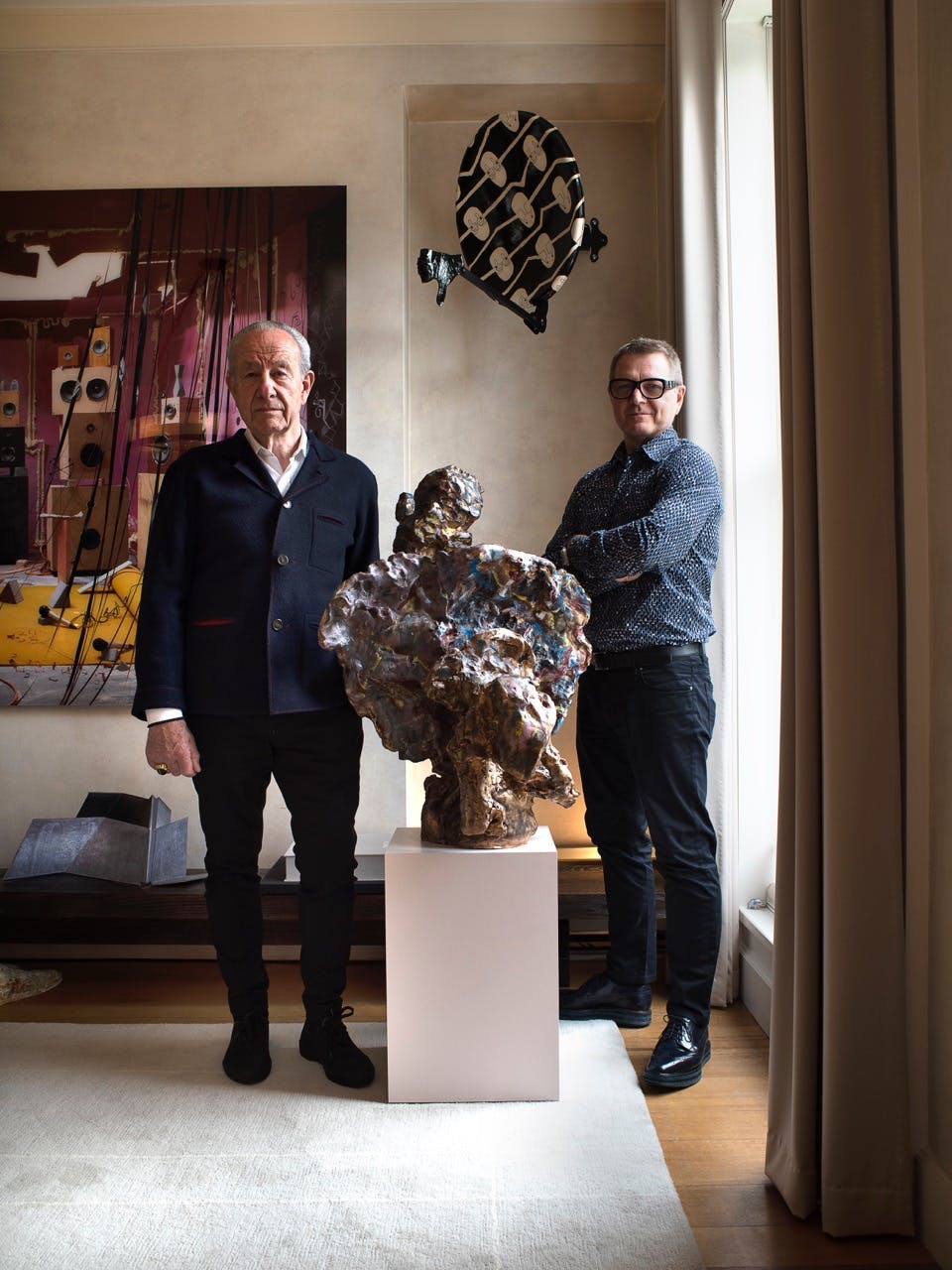
It is notable that Collett-Zarzycki’s clients tend to return many times over with multiple projects, while other, larger-scale collaborations span a number of years. This can be explained, in part, by the way that the practice takes time to listen to its clients but also by the way that it combines so many different disciplines within one rounded and cohesive design approach. Between them, Anthony Collett and Andrzej Zarzycki have a strong foundation in architecture, engineering, interiors, garden design and fine art. These talents are mirrored and reinforced by the 20-strong team of architects and designers within their London atelier. For the practice’s patrons there is reassurance in the fact that Collett-Zarzycki is a multidisciplinary studio able to encompass all aspects of the design process.
The Old Rectory, Chelsea, London
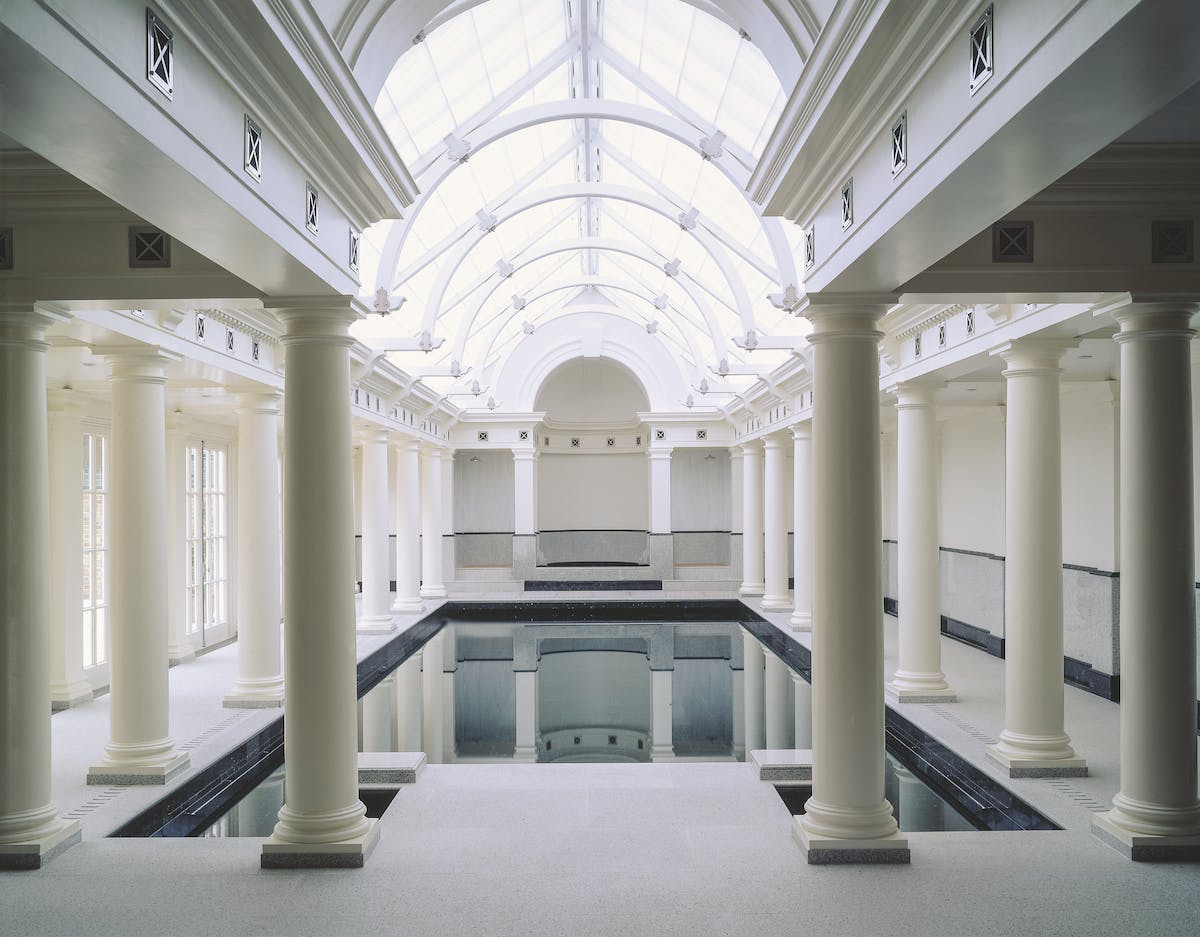
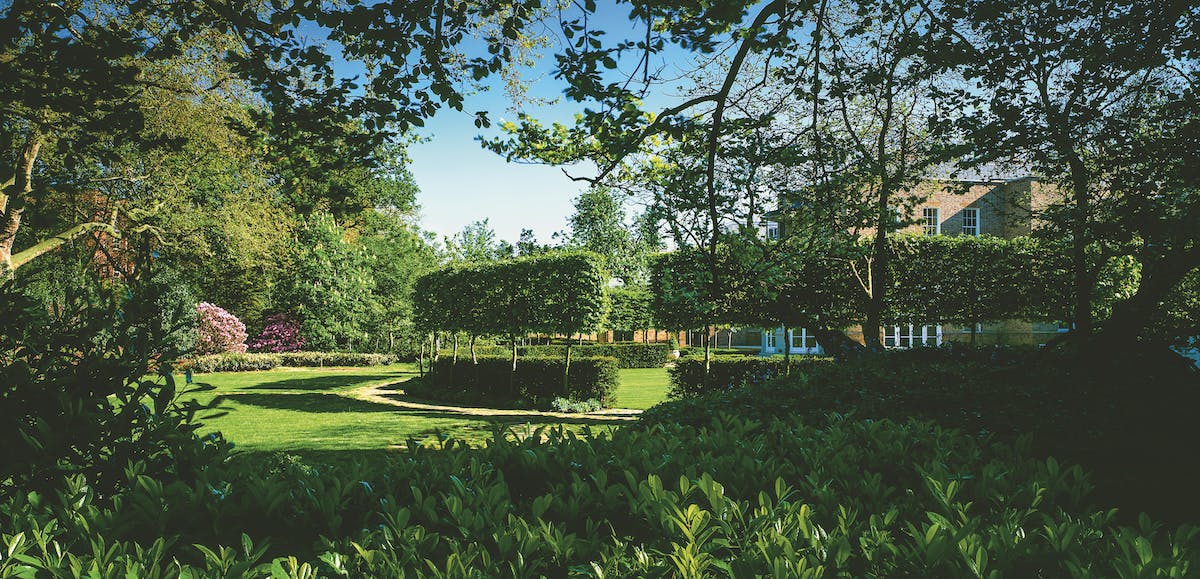
↑↑ The Old Rectory, Chelsea, London. This Georgian rectory, sitting in a walled garden extending to two and a half acres, was once home to the writer Charles Kingsley, author of The Water Babies. Collett- Zarzycki was asked not only to restore the existing building, which is listed, but also to extend the Rectory sympathetically and sensitively.
Top: The black granite indoor swimming pool, with arched open trusses supporting the glazed roof. Bottom: The landscaped gardens of The Old Rectory with pleached hornbeams in a crescent formation; this is one of the largest private gardens in central London.
“It’s a holistic and complete approach to design”, says Zarzycki. “While we are thinking about the structure and construction of a building, we also have in mind the detailing, the colours and the textures of the rooms and spaces within it. Some architects venture into furniture and lighting but stop there. We carry all the way through to the end, including furnishings, fabrics, rugs. We have even designed a range of cutlery for one of our clients.”
In this respect, Collett-Zarzycki has much in common with designers of both the Arts & Crafts and mid-century modern period who took a more holistic approach. One thinks, in particular, of Arts & Crafts architects and designers such as Charles Voysey, Edwin Lutyens and Charles Rennie Mackintosh, all of whom fused architecture with interiors to create their own gesamkunstwerks – total works of art. There is, certainly, a strong personal interest in the Arts & Crafts era in general that periodically resurfaces in Collett-Zarzycki’s work, related to both the use of natural materials and an artisanal approach that emphasises craft and handmade design.
The Glebe, Chelsea, London
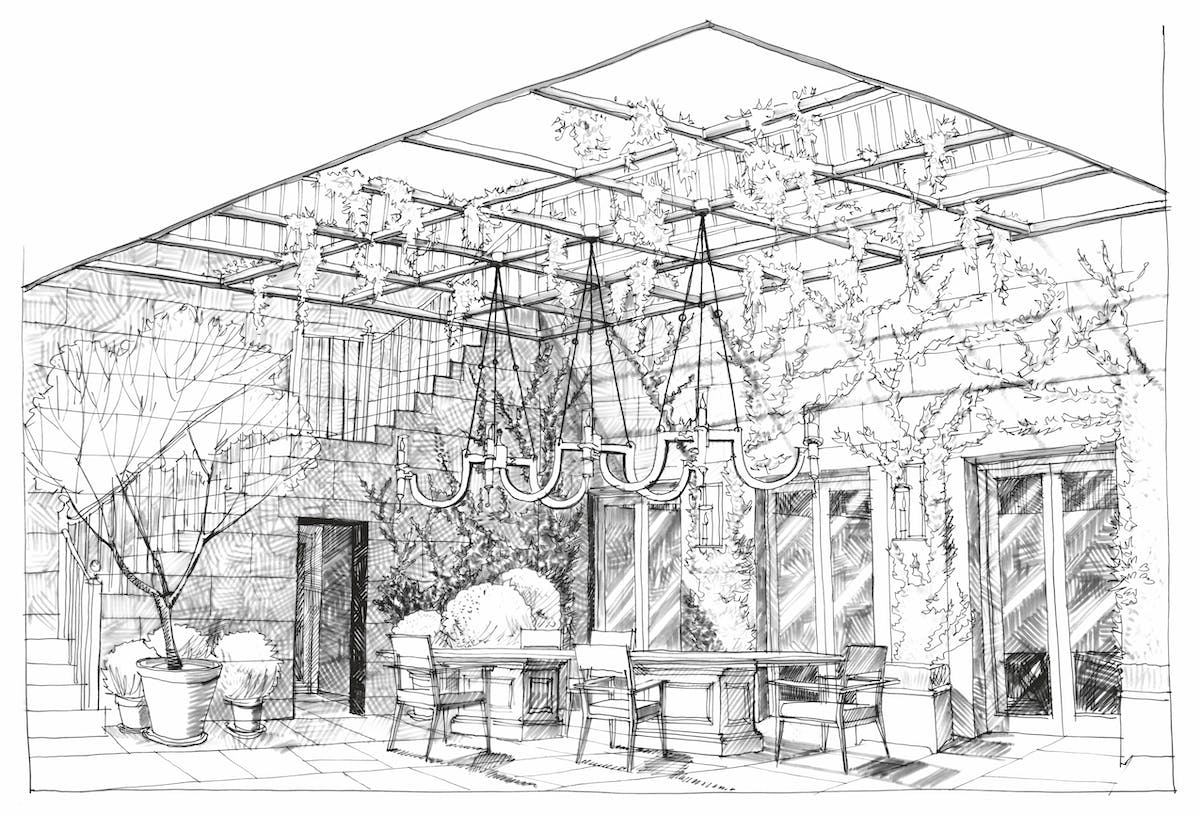

↑↑ The Glebe, Chelsea. Formation Architects, Collett-Zarzycki and Gumuchdjian Architects are working together to create seven luxury dwellings and two villas within the retained walls of the former Jamahiriya School, situated on Glebe Place, Chelsea. The project is due to complete in 2019.
Top: A Collett-Zarzycki client presentation showing the proposed private outdoor dining area within a courtyard. Bottom: An elevation drawing of the double volume drawing room at The Glebe in Chelsea, London, including the placement of furniture.
One also thinks of multidisciplinary mid-century modern designers, such as Alvar Aalto and Gio Ponti, who similarly traversed the boundaries between architecture, interiors and furniture design with great dexterity. There is, arguably, a degree of mid-century playfulness in Collett-Zarzycki’s use of colour, texture and sometimes pattern.
But alongside Anthony Collett and Andrzej Zarzycki’s own interests in Arts & Crafts and mid-century design, there is also a particular respect for vernacular traditions, whether that might be thatched southern African safari lodges or Alpine chalets. And, at the root of everything, there lies an almost innate understanding of neoclassical architectural principles, especially as they relate to proportion, symmetry and scale.

↑↑ Safari Lodge, Limpopo, South Africa. The beginnings of this project in South Africa lay in a wish to protect a particular landscape and its wildlife. With preservation and conservation in mind, Collett-Zarzycki’s clients bought over 5,000 acres of land in the Limpopo region, the country’s northernmost province. Left: Wildlife on the savannah, with the lodge perched on the hills in the background. Right: The open-sided dining area.
There are, therefore, many sources of inspiration that play upon Collett-Zarzycki’s work with the choice of aesthetic direction dependent on the site, setting and situation in question. But there are vital common threads that run through the entire portfolio, tying it together. These include some of the points mentioned above, especially the cohesive quality of the practice’s multilayered residences, the focus on natural and organic materials, and a degree of sophisticated playfulness. Beyond this there is a sensitivity to different settings and surroundings that comes of learning and also a special warmth and welcome that is evident within Collett-Zarzycki’s houses and apartments. Detailing is another key concern, allied to the focus on crafted materials.
“Detail has always been terribly important to us”, says Collett. “That applies to architecture, interior finishes and furniture and it could relate to an urban space that’s fine and jewel-like or a more rustic retreat. There’s this continual appetite to consider the detail of things and how they fit together. That often goes unseen or might be taken for granted by those that inhabit our spaces but it has a presence in our work, even if you have to look for it.”
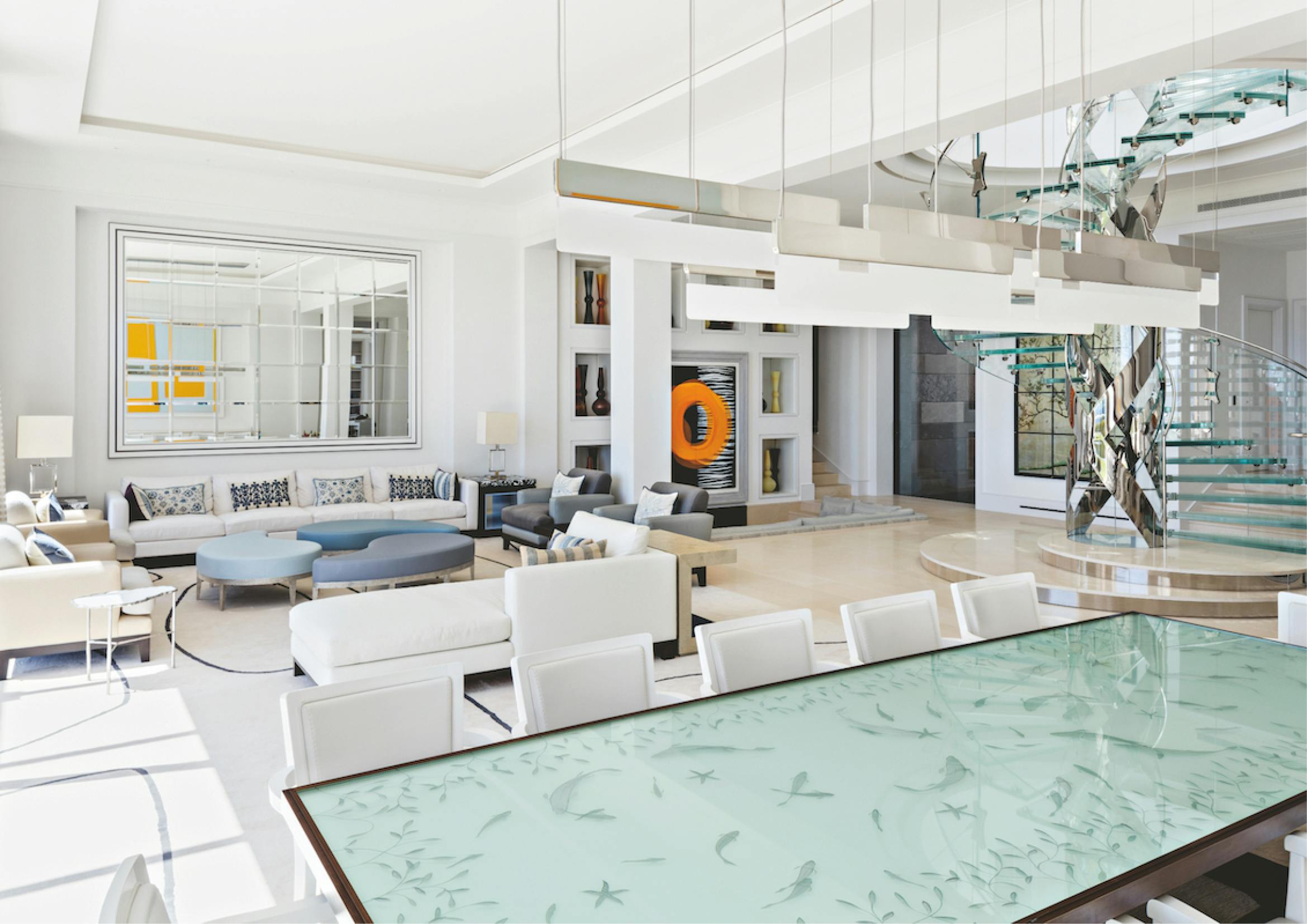
↑↑ Cannes Villa, Alpes-Maritimes, France. The main living room, with a custom-designed deep-etched glass dining table to one side by Collett-Zarzycki and featuring artwork by Paul Clifford and staircase by Eva Jiřičná.
It is fascinating to note how many interests, passions and points of reference are shared by both Anthony Collett and Andrzej Zarzycki, to the point of their being able to finish one another’s sentences. Clearly there is a deep understanding between them that comes partly through time, but also through a shared love of art, travel, food and culture. More than this, the two designers have much in common in terms of their personal histories and their childhoods in Zambia, all of which contribute to the evolution of a similar outlook upon the world.
Anthony Collett grew up in the north-western part of what was then Northern Rhodesia, now known as Zambia. His father emigrated from England during the Great Depression, becoming a senior civil servant in the colonial administration as well as meeting Collett’s mother, who was originally from Poland. Anthony Collett and his family lived in the Copperbelt Province, not far from the borders with the Congo and Tanzania, but moved around a number of times according to the different postings that came with his father’s job. Mostly it was small towns, but step off the main street and one would soon be in the bushlands.
↓↓ Gallery: Inside Anthony Collett’s West London townhouse
“That part of Zambia is on the borderland between savannah and a tropical climate”, says Collett. “So it was very green and verdant with a wonderful landscape, lots of water and lots of proper wildlife – snakes, crocodiles, leopards. So there was this undercurrent of natural danger. There was no apartheid system where we lived so I grew up pretty much like everyone else and was very exposed to the local music, culture, art. It was very formative.”
Following on from local primary school, Collett was sent to boarding school in South Africa, which provided a very different kind of experience. The journey alone took four days each way by train. Collett would be among the first to get on the train, being so far north, but by the time they reached the school the train would be packed with schoolchildren.
“I suppose you would now look at it as a romantic sort of journey”, says Collett, “but over the years I spent about nine months of my life on that train from the age of seven to 17. The railway carriages were mahogany panelled with real leather upholstery and the dining cars were silver service. I hark back to it in some ways, just because of a nostalgia about how beautifully detailed the trains, liners and yachts were back then. Nothing was a veneer back then. It was all very real.”
Having excelled at school as a track athlete, Collett began to embrace fine art while he was at Rhodes University in Grahamstown on the Eastern Cape, where he first met David Champion, who would go on to become an artist and designer as well as a collaborator on future projects. Collett decided to transfer to the University of Cape Town, where he enrolled at the Michaelis School of Fine Art. He graduated with a degree in sculpture and soon chose to move to London, where he continued his studies at the Hornsey College of Art.
“Hornsey was a very exciting place to be in the 1960s”, says Collett. “Pop Art had just exploded and for me, coming from Zambia and South Africa, it was a major cultural shock. It wasn’t my first trip to England, because we did come as a family when I was a child, but it was massively liberating. My brother was at Oxford University at the same time and I would go and visit him, go punting on the Cherwell, and experience this whole other world.”
Following on from a diploma at Hornsey, Collett began to shift from fine art to applied art. He studied interior design, followed by a period working in a London architectural firm, and then enrolled at the Royal College of Art to study environmental design under two much-respected architects John Miller, and Edward Jones (of Dixon Jones), who became a key mentor. In all, Collett spent nine years studying architecture, interiors and art.
At the Royal College, Collett met John McLeod, who was also from South Africa. After graduating the two friends both went to work with John Stefanidis, one of the great figureheads of international interior design during the 1970s and 1980s. With an extraordinary list of clients, a highly educated approach to art and design, and a portfolio from Patmos to Piccadilly, Stefanidis also became a great mentor over the course of seven years.
“Along with Edward Jones, John was the other person in my life who was enormously influential. I learnt so much from him. He was an Oxford graduate and has an enormous sense of style and refinement. There was a discipline and a rigour about the way he worked and he was very particular about the details. A lot of that has stayed with me and even now, when I’m faced with a problem, I often think ‘how would John deal with this?”
Eventually, Collett decided that it was time to set up his own atelier. With the blessing of John Stefanidis, he entered a competition for a major residential project in Belgrave Square, which offered the impetus to set up a new practice and a joint venture with John McLeod, which saw the two designers collaborate on many commissions together. Later, there was a similarly collaborative relationship with David Champion. In 1990 Andrzej Zarzycki became a partner in the firm and since 1996 it has been known as Collett-Zarzycki.
Andrzej Zarzycki also grew up in Zambia. Both his mother and father were originally from Poland but left as refugees during the Second World War. Eventually they settled in Northern Rhodesia, around 1957, where his father started working as a civil engineer, focusing primarily on infrastructure projects such as bridges and airports. His career spanned independence (1964) and the early evolution of Zambia as an independent state under Kenneth Kaunda.
↓↓ Gallery: Inside Andrzej Zarzycki’s Victorian townhouse in West London
“We lived in the suburbs of Lusaka and our house was quite modest, but we did have an acre of land around us so we played outside a lot”, says Zarzycki. “I did spend a lot of my time outside as a child and we would only put on our shoes to go to school or to church. My mother always had a strong sense of home and wanted it to be beautiful, but we didn’t have design or architectural magazines around the house as a child. If there was a family link to the design world, then it was through engineering.”
There was a family friend who was an artist, however, and her example encouraged Zarzycki to begin drawing and sketching at home at a young age.
He began to think that he might like to do something in the future that involved drawing and using his hands. From the ages of ten to 17, Zarzycki attended a boarding school in Oxfordshire where his interest in art and drawing was not particularly encouraged or nurtured. But the setting itself did make an impression.
“It was called Divine Mercy College and it was not that divine and there was not much in the way of mercy”, recalls Zarzycki. “But the school was in a Christopher Wren building with Capability Brown gardens and interiors by James Wyatt. So something must have rubbed off.”
After school Zarzycki studied engineering. But he was not greatly inspired by the subject and went on to take a foundation course at the High Wycombe College of Technology and Art, followed by a degree in three- dimensional design, which embraced interiors and architecture. The College also offered opportunities to study furniture design and ceramics. Increasingly, Zarzycki became fascinated by the work of early modernist and mid-century architects and designers, from Adolf Loos through to Gio Ponti and Ico Parisi.
“One of my tutors there was John McLeod, who became a mentor. He was still working for John Stefanidis then but I did say to him that I would love to work for him one day. So after graduating I went to work for a firm as an architectural assistant but after nine months or so John McLeod called me and said that he was starting a practice with a friend of his, Anthony Collett. That was the early 1980s.”
During the early days of the Collett-McLeod partnership much of the work was focused on the reinvention and modernisation of period London homes. Over time, the work of the practice became increasingly multidisciplinary, expanding from its heartland within architecture and interiors to become holistic in nature. At the same time, Zarzycki found great encouragement from Anthony Collett and began to realise how much they had in common. “We both have Zambia in our DNA and we are certainly attracted to similar things. We both love cooking, we both love colour, and although we were educated in different places and at different times we do have a lot of similar influences. The great thing about Tony was that he also allowed me room to develop my own style and my own way of thinking so that when we started the partnership together I was able to bring more of my—own ideas to the practice.”

↑↑ Eaton Square apartment I, Belgravia, London. A view of the hall with an open connection to the living room on one side; the parquet flooring is in polished wenge. The mirror columns conceal fire curtains to allow the space to be part of the living room. The screen is a concealed door to the bedroom area.

↑↑ Eaton Square apartment II, Belgravia, London. Green glass sliding doors separate the study and dining room, which features zebrano veneered wall panelling and bespoke furniture by Collett-Zarzycki; the mid-century Italian ceiling light is by Venini.

↑↑Chelsea Duplex, London. The double height drawing room, with the dining area to the right. The sofas and other furniture are by Collett-Zarzycki while the artwork is by Sean Scully.
From 1996 onwards Collett-Zarzycki began to evolve and grow as an equal partnership. Many of the projects involve overlapping disciplines, encompassing architecture, interiors, landscape design and collections of furniture and lighting. As well as the in-house team, the practice also collaborates closely with a wider network of artisans and craftsmen of all kinds in order to create homes that are unique and bespoke.
This emphasis upon individuality and personality is a key theme in Collett-Zarzycki’s work and a central reason why clients come to the atelier in the first instance. With the arrival of a new client, there will usually be a series of joint meetings and ideas sessions but, moving onwards, either Anthony Collett or Andrzej Zarzycki will then take the lead as the project progresses.
“We brainstorm together and initial presentations would usually be done by the two of us”, says Anthony Collett. “But once the aesthetic direction and the initial design has been settled and the project is up and running then we will bring in a team of people from the office to work on it and then there is this tendency for one of the partners to peel off and continue directing the project and looking after client liaison. But there will always be this team supporting us, including the senior architects, the furnishings department and so on. But having said that both of us do tend to know what is going on with each other’s projects so we can then step in if something happens or if one of us is away from the office.”
This way of working is reinforced by the wide skill set held by both Collett and Zarzycki themselves, who are able to span the various disciplines and step between the different teams in the practice working on architecture, interiors, furniture and so on. Garden design is another important element, with Anthony Collett in particular passionate about the subject, with his own knowledge reinforced by a diploma in the field of landscape design. Communication is, therefore, continuous and open while this multidisciplinary way of working helps to ensure a harmonious and rounded result.
“We try to step away from fashion, which tends to lead towards something that dates very quickly. We have never followed fashion”
Andrzej Zarzycki
“Our projects always reflect our clients and their wishes, so of course that means that what we do is bespoke and fully tailored to them”, says Andrzej Zarzycki. “But it also tends to have this timeless quality because we try to step away from fashion, which tends to lead towards something that dates very quickly. We have never followed fashion.”
“This is something that I first learned when I was working with John Stefanidis”, Collett adds. “There is a timeless quality to John’s work and he was always very clear that you should not be ‘fashionable’ because it’s so transient. We would always prefer to concentrate on context rather than fashion and create something that feels as though it truly belongs. There are many words that I would use to describe what we do: classical,
contemporary, traditional, eclectic, modern. But it all depends on where we are working and we will adapt our vocabulary and our palette accordingly.”
This feature is an extract from “Collett-Zarzycki: The Tailored Home”, written by Dominic Bradbury and published by Lund Humphries.
The book is available to buy here, or via the new PrimeResi Bookshop (£40)











